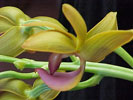|
|
|
|
|
| |
Flasks of
Mormodes andicola 'Profpam' × self |
|
| |
|
|
| |
|
|
Click to Enlarge

Pod Parent Flower |
Click to Enlarge

Offspring 'MC4104' Flowers |
Click to Enlarge

Offspring 'MC4104' Blooming Plant |
| Offspring photos are siblings of the plants you would receive. |
|
|
|
| |
Culture Notes from Donor: Parent plant: Temperature range I (60-83°F). Mormodes are intermediate- to warm-growing plants. Since they are deciduous they require a rest. During the rest period, provide some humidity and misting because if left too dry the bulbs will shrivel; if provided too much moisture, rot will occur.
Comments: Parent plant: Waxy and unique smelling, beautiful mauve lip, birdlike shape, and very tropical looking. Large plant.
For additional origin/habitat information supplied courtesy of
Charles and Margaret Baker, see further below, near the bottom of this page.
|
Temperatures we attempt to use in the lab & greenhouse:
| For Species: |
|
Spring, Summer, Autumn: days average 85°F, nights 70°F; best fit is Warm-Intermediate 87-64°F
(Source:
Baker's Web OSC) |
| For Species: |
|
Winter: days average 83°F, nights 65°F; best fit is Warm-Intermediate 87-64°F
(Source:
Baker's Web OSC) |
|
About the name...
| Etymology of |
andicola |
|
From Latin "andicolus" living in the Andes.
(Source:
Mayr & Schmucker 1998) |
| Etymology of |
Mormodes |
|
From Greek "mormo" phantom, frightful object; "-oides" resembling.
(Source:
Pridgeon 1992) |
| Pronunciation of |
Mormodes |
|
mor-MOE-deez
(Source:
Pridgeon 1992) |
|
If you would like to direct someone to this web page, please copy and paste this URL into your email:
http://troymeyers.com/d?013827
| Flask Information |
| Availability: |
We have sold all of the flasks for this item. |
| You should: |
Consider getting individual plants or compots instead of a flask.
You can place a "Notify Flask Recipients" Request, and either we or a flask recipient may contact you when plants are available.
You may also place a "Notify Retries" Request, and if an identical pollination (the same parents) is done again, we'll let you know.
You may reserve a flask, but it's very unlikely you'll get one ...this could only happen if we found a flask that we didn't know we had. |
| Yield Estimate: |
230 plants (based on flask surveys done 03/22/2004 through 07/30/2004)
|
| Plantlet Sizes: |
From many flasks 10 - 70 mm plants (based on flask surveys done 03/22/2004 through 05/24/2005)
From one most recently surveyed flask 30 - 50 mm (05/24/2005)
|
|
You might also want to:
|
View the seed assay for this item.
View items of the same species.
View items of the same genus.
|
| Ordering Information |
| You are not currently logged in. |
|
You must be a registered user and be logged in to reserve a flask or place a notification request. Please log in:
|
|
|
|
|
|
| |
The origin/habitat information below is supplied courtesy of Charles and Margaret Baker
The following information is based on the name of the plant provided by the donor, and assumes that the name is correct. If the plant has been misidentified, then the following information may not be correct.
This text is copyrighted by the Bakers and may not be reproduced without permission.
ORIGIN/HABITAT: Bolivia. This orchid was discovered in the department of
La Paz in the province of Larecaja near Mapiri. It was growing on the
eastern slope of the Andes in northwestern Bolivia at 2800-3100 ft.
(850-950 m).
More about this information and the Bakers...
|
|
|
| |
|
|
|